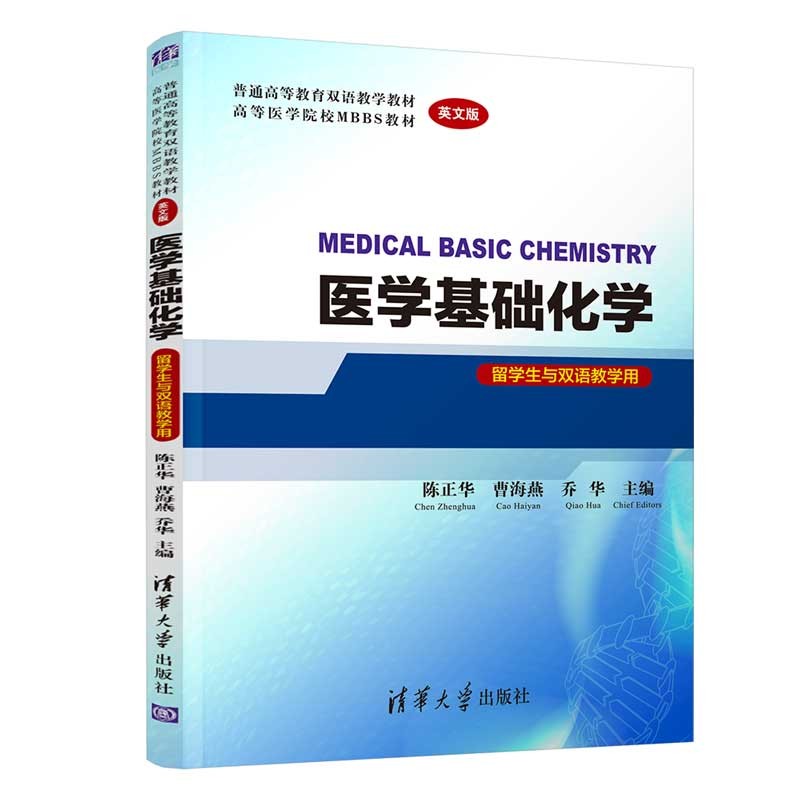
包邮医学基础化学 MEDICAL BASIC CHEMISTRY(英文版)(留学生与双语教学用)

- ISBN:9787302577850
- 装帧:70g胶版纸
- 册数:暂无
- 重量:暂无
- 开本:16开
- 页数:156
- 出版时间:2021-08-01
- 条形码:9787302577850 ; 978-7-302-57785-0
本书特色
适读人群 :留学生与双语教学用医用基础化学是一门公共基础课,主要介绍与医学有关的化学知识。学习该课程有利于后续课程的学习,能为学生将来的医学研究和临床工作打下坚实的基础。根据医学生的专业特点、需求,结合留学生的语言特点和自身学识基础,由浅入深系统的介绍化学基础知识。讲述化学在医学研究和临床中的应用,弥补其它教材的不足。采用PBL(以问题为中心)的方法编写教材。
内容简介
医学基础化学是为了适应医学各专业的特点和需要而开设的一门基础课程。《医学基础化学(英文版)(留学生与双语教学用)》是专为来华医学留学生编写的全英文教材,也适用于普通高等院校双语教学使用。 《医学基础化学(英文版)(留学生与双语教学用)》内容包括无机化学、分析化学和物理化学中与医学卫生领域相关的基本理论和基础知识,重点突出医学知识、信息和化学理论的密切联系,在确保化学知识详尽介绍的同时,为化学和医学建立起一座桥梁,不仅有利于后续课程的学习,也能为学生将来从事临床医学和研究T作奠定坚实的基础。
目录
作者简介
主编陈正华:毕业于南开大学化学系,硕士学位,副教授,是天津医科大学**批授予留学生教学资格的教师。1995年至今在天津医科大学从事医用化学本科生、留学生教学。从事留学生英文授课17年。主持国家“十五”重点立项课题“21世纪中国高等学校农林/医药类专业数理化基础课程的创新与实践”子项目 ,医学化学(基础化学、有机化学融为一体)新课程体系的创新与研究”,主持天津医科大学教学研究基金“医用基础化学双语教学课程建设”,参与卫生部课题---视听教材医用化学综合性实验。主编供留学生使用的教材《GENERAL CHEMISTRY》,《Guid to Chemical Experiments》,《Experimental Organic Chemistry Fo rMedical Students》,校内出版。主持编写教育部全英文临床医学专业《基础化学英语教学大纲》。参编教育科学“十五”国家规划课题研究成果《医用化学实验》 高等教育出版社,《基础化学习题解析》 高等教育出版社, 《医用基础化学实验》 科学普及出版社。
-

引力和宇宙学-广义相对论的原理和应用
¥95.2¥119.0 -

中国贸易差额.货币供给与金融安全
¥24.0¥32.0 -

中西医消化病学
¥57.8¥116.0 -

低碳经济视角下可再生能源产业发展的就业效应与实现路径研究
¥21.2¥36.0 -

百年百部·中国儿童文学经典书系·精选注音书:稻草人
¥13.0¥25.0 -

基于计算智能的军事冲突建模
¥27.9¥79.0 -

唤醒你的大脑系列思维导图:让你的学习更高效/唤醒你的大脑系列
¥17.3¥38.0 -

建筑物电子信息系统防雷技术设计手册-(第二版)
¥29.9¥76.0 -

(历史小说)传奇可汗:忽必烈(上下册)
¥86.9¥158.0 -

辽河流域基于环境容量的污染物排放总量控制研究
¥31.0¥50.0
-

温疫论
¥2.8¥5.0 -

急诊科里的一千零一夜
¥19.6¥58.0 -

先醒斋医学广笔记
¥4.5¥10.0 -

问中医几度秋凉
¥38.2¥59.0 -

内外伤辨惑论-局方发挥
¥1.9¥5.0 -

临床常用百药精解-国医精粹口袋书系
¥11.2¥32.0 -

四诊扶微
¥5.8¥16.0 -

剑桥世界人类疾病史
¥93.6¥260.0 -

中医手诊图释
¥9.4¥28.0 -

黄帝内经鉴赏辞典(文通版)
¥16.4¥28.0 -

格致余论
¥2.2¥6.0 -

寻回中医失落的元神2:象之篇
¥29.4¥49.8 -

内证观察笔记:真图本中医解剖学纲目
¥32.3¥46.0 -

中华国学经典精粹 丹溪心法
¥2.5¥12.0 -

脉因证治
¥4.8¥13.0 -

活幼心书
¥5.6¥15.0 -

联袂药性赋白话解-国医精粹口袋书系
¥6.3¥18.0 -

临床常用百穴精解-国医精粹口袋书系
¥9.7¥29.0 -

漫画黄帝内经(上)
¥39.3¥89.0 -

漫画黄帝内经.下册
¥35.0¥79.0











